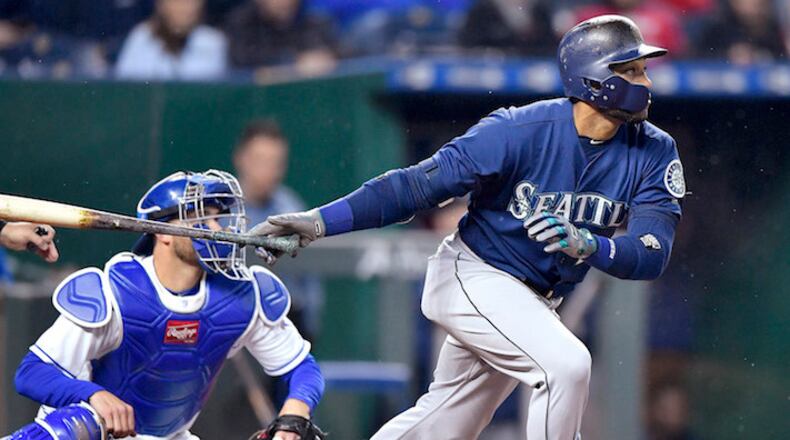Maybe it's cool to be cautious?
Whatever the impetus or reasoning, the latest fashion fad on the field is face-guard flaps.
Not familiar? Well, you haven't been watching baseball lately. The majority of hitters have added the padded plastic that is bolted to the earflap on the batting helmet and extends down a player's jaw line, covering the cheek bone.
In the Mariners' lineup Saturday night, Robinson Cano, Nelson Cruz, Mitch Haniger and Mike Zunino all had the face guards attached to their helmets. Outfielder Guillermo Heredia, who wasn't in the lineup, and first baseman Ryon Healy, who is on the disabled list, also wear it.
This isn't just a trend on the Mariners. When the Astros played in Seattle, six of the nine players in the lineup had face guards.
"With as hard as guys are throwing right now and the movement they have on the ball, it makes sense," M's manager Scott Servais said.
In past years, players who had been previously struck in the face were the only ones that wore the guards.
Haniger was the first player on the Mariners to do so last season. He doesn't consider himself a trendsetter. He didn't particularly enjoy his reasons for being the first.
"Yeah, no one wants to get hit in the face," he said.
On a bright and sunny Saturday at Safeco Field on July 29, Mets right-hander Jacob deGrom uncorked a 95-mph fastball that rode up and in on Haniger. At the last second, he was able to turn his head as the ball struck him in the cheek and mouth, tearing apart his upper lip and leaving a facial contusion.
"For whatever reason, I just wasn't seeing it well," he said. "Maybe the shadows, and the really sunny day game. I still think now I can get out of the way of that pitch. I'm just lucky it wasn't worse than it was."
When Haniger returned from the disabled list, he had the flap attached to his helmet and his teammates had plenty of questions.
"They kept asking, 'How is it and how does it feel?' " he said. "I was like, 'Visually it's not going to bug you at all. It's not going to take away from seeing the ball whatsoever. It's just the weight more on that one side and having it there.' "
In past years, the flap was attached to the helmet by clubhouse managers or attendants. But that's changed. The helmets, which are more than $150, have to be ordered specifically with the guard attached by the manufacturer.
It's why Haniger played the first game of the season without wearing the guard. The Mariners' matte-finished helmets with the face guards didn't arrive in time for opening day.
Did he feel naked without it?
"It felt really weird," he said. "But once I got in the box I was so focused that I forgot about it."
Cano started wearing the guard last year after Haniger's injury but went back to his old helmet.
"I didn't feel comfortable," he said. "It was hard to get used to."
But he was determined to get used to it and wear it going forward in 2018.
"I said to myself, 'I'm going to use it all spring training to get used to it,' " he said.
Why was it so important to him?
"We got a lot of guys that pitch inside," he said. "I've been hit in the head maybe four or five times. Sometimes pitchers are going to throw inside, and it's close to your face. Why wouldn't you protect your face? Why wouldn't you do it?"
When it was mentioned that he had to protect his megawatt smile, Cano grinned at the suggestion.
"Well, yes, of course," he said. "But it can be something that could put you out of the game forever. The more you can prevent anything, you should do it. If it's out there, you should use it.
The scouting report on Cruz is tie the large man up with fastballs up and in. Aware of it, he decided to add the faceguard.
"I mean, why not?" Cruz said.
Others aren't sold.
Jean Segura listened to Cano's answers about the faceguard and shook his head.
"I don't like it," he said. "It feels weird. It would bother me."
Cano was quick to comment.
"He should be wearing one with the way he hits," he said. "He's always leaning out over the plate."
Baseball players are creatures of habit and routine. And even something as changing the safety equipment can take away a level of comfort.
"There's two ways to look at it," third baseman Kyle Seager aid. "You put something on your face that you aren't used to, that's uncomfortable. But at the same time, not worrying about getting hit in the face should make you more comfortable in the box."
For Zunino, his logic was pretty simple. He has facial protection when he catches 100 mph fastballs, why not have some additional protection when he's trying to hit them.
"I get hit in the face enough," Zunino said. "I will take the protection."
It was a conversation with Haniger that changed his mind.
"Like Mitch said, you can miss a week with a concussion or you can miss months if you to have to get your face reconstructed," Zunino said. "I'd rather be safe than sorry."
About the Author
